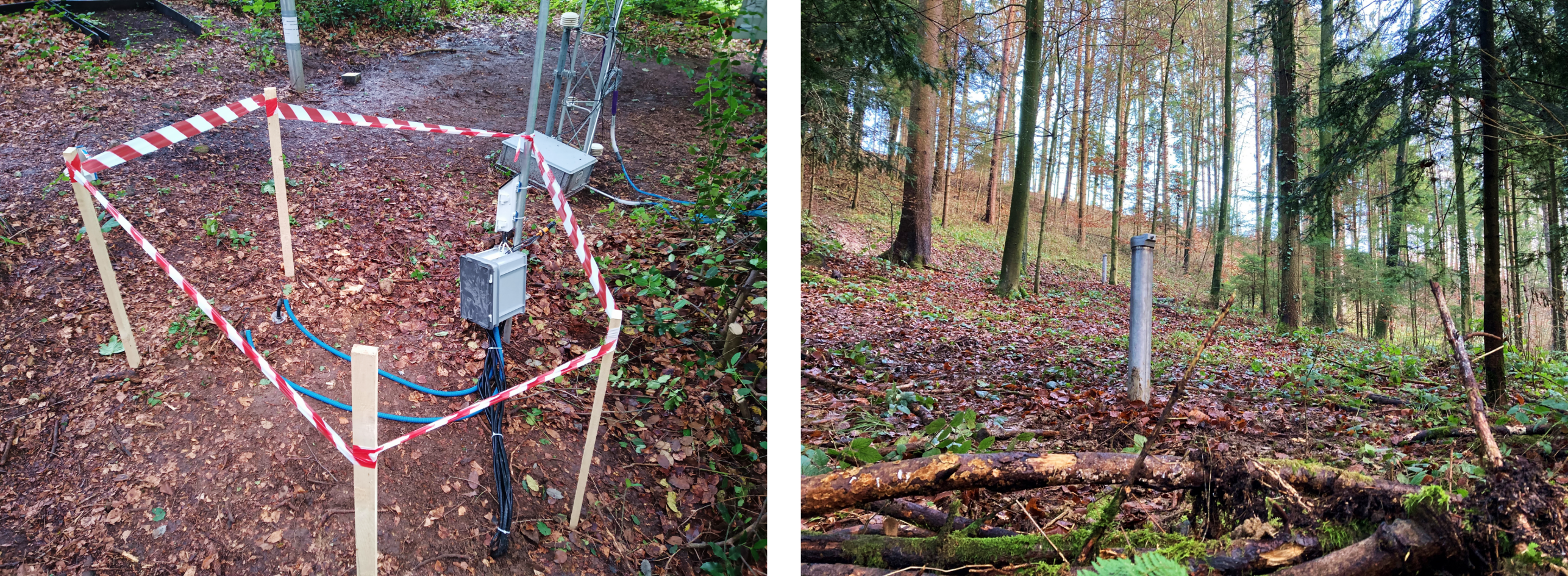Research Focus

The aim of our WaldLab Forest Exerimental Site is to observe the quantity and chemical composition of all water fluxes across the forest water cycle to gain insights into the dominant processes of water transport and mixing. Our research focus around the following main topics:
Forest canopies modulate the amount and chemical composition of precipitation reaching the forest floor. Around 20 % of annual precipitation are intercepted in the canopy and evaporate back to the atmosphere. The magnitude and chemical composition of throughfall and stemflow are affected by seasonal differences in canopy structure. We measure the magnitude of throughfall and stemflow and analyze the chemical composition of these fluxes i.e., major ions and stable water isotopes to reveal the transport and mixing processes occurring in forest canopies.

Floriancic MG & Kirchner JW, 2024
Isotopic offsets in throughfall and stemflow may alter estimates of winter precipitation fractions across forested catchments; Hydrological Processes (external pageLinkcall_made)
Grundmann M, Molnar P, Floriancic MG **in review**
Quantification of Enrichment Processes in Throughfall and Stemflow in a Mixed Temperate Forest; Hydrological Processes
Forest-floor litter and deadwood can retain substantial volumes of water, thus affecting evaporation and soil-moisture dynamics. However, litter layer wetting/drying dynamics are often overlooked when estimating forest water budgets. At our WaldLab Experimental Field Site around 18 % of annual precipitation are intercepted in the forest floor litter layer and evaporate back to the atmosphere. We measure the magnitude and chemical composition of litter layer water fluxes with an intensive field setup including volumetric water content measurements, lysimeters, storage capacity estimates and the analysis of stable water isotopes. Our field measurements are supported by a number of laboratory experiments assessing the storage capacity and retention behavior of forest-floor litter and deadwood.

Floriancic MG, Allen ST, Meier R, Truniger L, Kirchner JW & Molnar P, 2022
Potential for significant precipitation cycling by forest-floor litter and deadwood
Ecohydrology; DOI: 10.22541/au.166209855.56534808/v1 (external pageLinkcall_made)
The controlling transport processes and corresponding times scales for water to infiltrate into, and percolate through layers of the subsurface are poorly understood. At our WaldLab Experimental Field Site we monitor soil water content and tension in 10, 20, 40 and 80cm depth at various locations across the hillslope. In addition, we also have 10 boreholes up to 7 m depth were we monitor groundwater levels. In all these different locations we also collect water samples to analyze major ions and stable water isotopes to reveal the transport processes of waters along the hillslope. Understanding the transport and mixing of waters allows us to assess how water moves across different layers of the subsurface.

Floriancic MG, Allen ST & Kirchner JW **in review**
Young and new water fractions in soil and hillslope waters
Hydrology and Earth System Sciences (external pageLinkcall_made)
Floriancic MG, Allen ST & Kirchner JW **in review**
Isotopic evidence for seasonal water sources in tree xylem and forest soils
Ecohydrology (external pageLinkcall_made)
2021 – 2025 PhD Project - Stefano Martinetti:
"QUASI - Quantifying Water Stress at the Soil-Plant-Atmosphere Interface",
ETH Grant: ETH-27 21-2
Forest trees greatly influence both the routing of water downward into the subsurface and the re-routing of water upward through water uptake and transpiration. To reveal how the subsurface soil water pools used by trees change across seasons, we conduct a series of measurements at beech and spruce trees (including measurements directly at the roots) at high spatial and temporal resolution: sapflow, dendrometers, leaf and stem water potentials, stomatal conductance, xylem isotopes. In previous research we could reveal the major tree water uptake depths, seasonal patterns and depth shifts in root water uptake, adaptation strategies of beech and spruce to water limitations.

Floriancic MG, Allen ST & Kirchner JW, 2024
Isotopic evidence for seasonal water sources in tree xylem and forest soils
Ecohydrology (external pageLinkcall_made)
Martinetti S, Molnar P, Carminati A, Floriancic MG **in review**
Plant hydraulic traits and water use strategies modulate root water uptake and transpiration in beech and spruce
Plant, Cell & Environment (external pageLinkcall_made)
Understanding runoff generation processes in forested catchments is important for sustainable water management. It is currently unclear how much streamflow is derived from old water stored in the subsurface, versus more recent precipitation that reaches the stream via near-surface quick flow processes. To reveal the runoff generation processes we use a dense network of soil water content sensors in combination with nested gauging stations in our 0.3 km2 large forested catchment. We also analyze major ions and stable water isotopes at daily resolution at multiple locations. All these measurements reveal the partitioning of older and younger streamflow across the catchment and allow assessing runoff generation mechanisms at different antecedent wetness conditions.

Floriancic MG, Stockinger M, Kirchner JW, Stumpp C **in review**
New water fractions and their relationships to climate and catchment properties across Alpine rivers
Hydrology and Earth System Science (external pageLinkcall_made)
